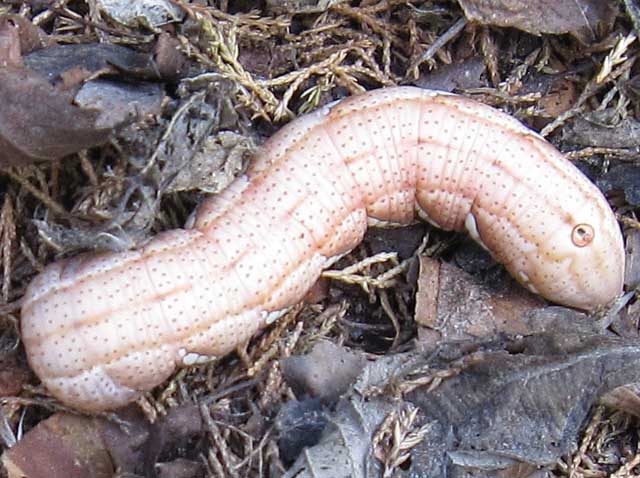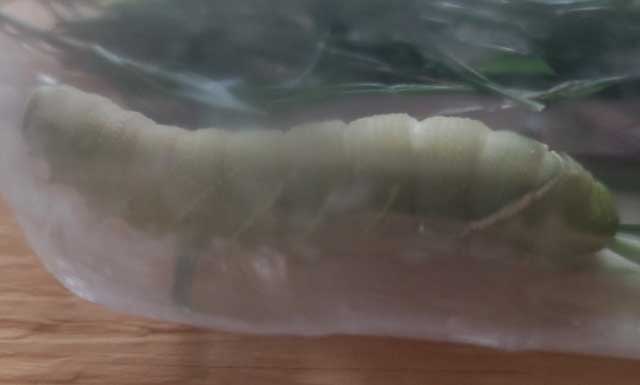Sphinginae subfamily
Sphingini tribe:
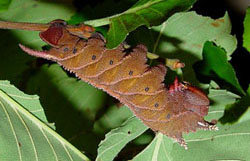 |
Ceratomia amyntor
DF/BW,
Elm Sphinx, Four-horned Sphinx:
Elm (Ulmus), birch (Betula), basswood
(Tilia), cherry (Prunus).
Both green and brown forms. Four horns near the head are diagnostic. |
Ceratomia amyntor, Saskatoon, October 5, 2008, Doug Freestone.
Ceratomia amyntor, Saskatoon, September 6, 2011, Betty Wotherspoon.
 |
Ceratomia undulosa WO, Waved Sphinx: Fraxinus, Ligustrum, Quercus, Crataegus,
Chionanthus virginicus Fifth instar spiracular ovals decidedly red, anal horn is off-white to pinkish laterally.
|

| Lapara bombycoides
WO,
Northern Pine Sphinx: Without anal horn; feeds on pines.The long stripes and reddish brown afford great camouflage.
|
 |
Manduca quinquemaculatus WO, Five-spotted Hawkmoth:
Tomato Hornworms: black horn at the end of the abdomen. Larvae feed on potato, tobacco, tomato, other plants in
nightshade family (Solanaceae).
|
 |
Sphinx chersis
WO/FR, Northern Ash Sphinx, Great Ash
Sphinx: Pale bluish-green. Head: pair of yellow
lateral bands meeting at apex. Oblique, lateral stripes:
pale, bordered anteriorly with darker green.
Ash, lilac, privet, cherry, quaking aspen.
|
Sphinx chersis final instar, Lumsden Beach, August 11, 2011, Fiona Ramsay.
 |
Sphinx drupiferarum
WO, Wild Cherry Sphinx: Hide by day; feed primarily on
cherry, plum, apple at night; Amelanchier nantuckensis in
Massachusetts; in Michigan on Prunus serotina from eggs readily oviposited.
|
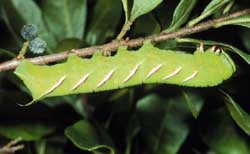 |
Sphinx gordius, WO, Apple Sphinx:
Ranges from brown with black borders through brownish gray with paler borders to pale gray with no
borders. It is probably Sphinx poecila that is present in Saskatchewan. |
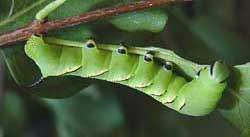 |
Sphinx kalmiae WO, Laurel Sphinx:
Black bands on green head. Black feet, black band above yellow-green legging on abdominal feet.
Black oblique lines anterior to creamy white lines. Anal horn: blue with extensive black markings in final instar.
|
 |
Sphinx luscitiosa WO,
Canadian Sphinx, Clemen's Sphinx: Willow (Salix), poplar (Populus), birch (Betula),
apple (Malus), ash (Fraxinus), waxmyrtle (Morella), northern bayberry.
|
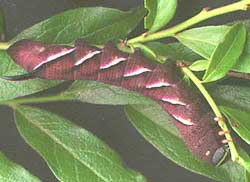 |
Sphinx poecila
WO, Poecila Sphinx:
If you have blueberries in the woods, then you probably have the
Poecila Sphinx. There are both a green form and a purple form.
|
 |
Sphinx vashti WO, Snowberry Sphinx:
Common snowberry (Symphoricarpos albus) and on coralberry (S. orbiculatus). Note the two golden lines
of slightly raised bumps, one just behind the head, the other on the thorax. |
Smerinthini Tribe:
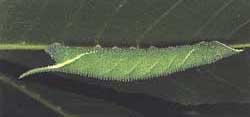 |
Amorpha juglandis
WO??, Walnut Sphinx:
Walnut, butternut (Juglans),
hickory (Carya), alder (Alnus), beech (Fagus),
hazelnut (Corylus), hop-hornbeam (Ostrya). questionable |
 |
Pachysphinx modesta WO/DC,
Modest Sphinx, Poplar Sphinx: Larvae feed on poplars, cottonwood. Anal horn: very rudimentary in final instar.
|
Pachysphinx modesta final instar, Saskatoon, Saskatchewan, August 6, 2021, Darla Currie
 |
Paonias excaecata WO, Blinded Sphinx:
Willows, birches, cherries. I have also found them in the wild on oak in eastern Canada. generally more eastern species
|
 |
Paonias myops WO, Small-eyed Sphinx:
Wild cherry species are favorites, but eggs will also be deposited on birches and other forest trees.
There are varying degrees in the amount of red markings along the sides.
|
 |
Smerinthus cerisyi WO,
Cerisy's Sphinx; Larvae: pale green, with granular skin, pale lateral diagonal lines, faint red
spiracular circles, very pale longitudinal lines running from
head to more pronounced anal diagonal line. Green heads: bounded dorsally with pale yellow inverted "V".
|
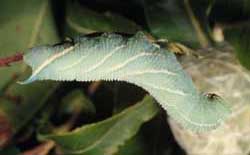 |
Smerinthus jamaicensis WO, Twin-spotted Sphinx:
Birches, cherries, but are expecially fond of poplars and willows. Red markings on sides vary greatly from specimen to specimen.
|
Macroglossinae subfamily
Dilophonotini Tribe:
See Hemaris comparison to help distinguish the next three species.
 |
Hemaris diffinis
WO,
Snowberry Clearwing: Snowberry (Symphoricarpos),
honeysuckle (Lonicera), Coralberry, viburnums, Blue Dogbane
(Apocynum), dwarf bush honeysuckle (Diervilla lonicera).
Horn: black; yellow base.
|
Hemaris diffinis fifth instar, Regina, July 26, 2011, courtesy of Tim Taylor.
 |
Hemaris gracilis WO, Slender Clearwing or Graceful Clearwing:
Blueberries including low bush blueberry (Vaccinium vacillans), and laurel (Kalmia), all in the heath family (Ericaceae).
|
 |
Hemaris thysbe
WO, Hummingbird Clearwing: Orangey-pink prepupal form. Lateral line runs
from S1 to blue horn. Viburnum and related plants. generally more eastern species
|
Philampelini tribe:
 |
Eumorpha achemon
KE/DW/ET,
Achemon Sphinx:
Grape (Vitis), Virginia Creeper
(Parthenocissus quinquefolia), other vines, ivies
(Ampelopsis). Light green form and a darker (tan/brown)
form. Note six "segmented" oblique lines.
|
Eumorpha achemon, Estevan, Saskatchewan, September 10, 2010, Karen Edwards.
Eumorpha achemon, Regina, Saskatchewan, September 5, 2013, Darlean Weigetz.
Eumorpha achemon, Regina, Saskatchewan, August 4, 2019, Erin Tyson.
Macroglossini Tribe:
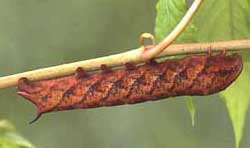 |
Amphion floridensis
WO,
the Nessus Sphinix:
In additon to Virginia creeper larvae accept Grape (Vitis),
ampelopsis (Ampelopsis), and cayenne pepper (Capsicum).
Larvae are green until the final instar.
|
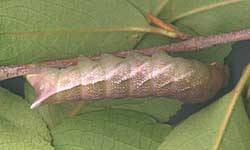 |
Darapsa choerilus
WO, Azalea Sphinx:
Azalea, Viburnum progress very rapidly. Larva (left) on Viburnum cassinoides is getting ready to
pupate. Color change from green to light burgundy-brown indicates pupation is imminent. |
 |
Hyles euphorbiae
MKM/DF, Spurge Hawk Moth:
Young larvae: variously patterned with green, yellow,
black; older larvae: distinctive red, black, yellow, white
color pattern. May approach 10 cm; when
disturbed, regurgitate slimy green liquid.
Leafy spurge.
|
Hyles euphorbiae, Swift Current, July 31, 2007, Marnie Kay-Macmillan
Hyles euphorbiae, Zehner (12 miles NE of Regina), Dave Fries
 |
Hyles gallii WO, Bedstraw Hawk Moth or Gallium Sphinx:
Larvae come in black and in brown forms (see bottom of page) and often feed on Epilobium (fireweed).
|
 |
Hyles lineata
WO, White-lined Sphinx:
Larvae: variable; Willow weed (Epilobium), four o'clock (Mirabilis),
apple (Malus), evening primrose (Oenothera), elm
(Ulmus), grape (Vitis), tomato (Lycopersicon),
purslane (Portulaca), Fuschia. All with red/black swellings split by
dorso-lateral lines. |
 |
Proserpinus flavofasciata
WO, Yellow-banded Day Sphinx.
Penultimate instar pale green with pair of pale,
dorsolateral lines running from head to base of short caudal horn.
Last instar: brown-black with numerous black dots; caudal horn
replaced by black button surrounded by white ring edged with black.
|
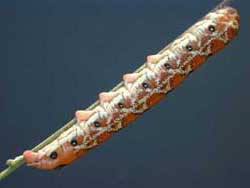 |
Proserpinus juanita
WO,
Juanita Sphinx:
Newly-hatched caterpillars eat eggshells.
(Onagraceae) including evening primrose (Oenothera), gaura (Gaura),
and willow weed (Epilobium). Michael Van Buskirk has found them on Guara biennis in Missouri.
|
|
|



